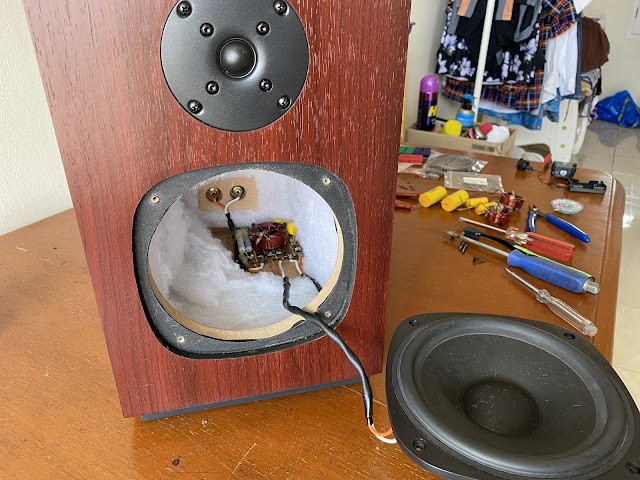We are fully aware that the speaker is the end of every audio chains. In my experience, once I get satisfy with a pair of speaker, then it will sit there for very long time. The reason is because every speaker has their own characteristic to match with the room acoustic and personal taste. This is not easy to having the right one, and of course with affordable price.
My speakers is the 2-way system, they are consisting of 2 drivers from my local brand, SB Acoustic SB16PFC25-8 for mid-bass and SB19ST-C0004 for tweeter. I've listening to this speaker for quite long time with the -12dB crossover point, or commonly known as 2nd order slope.
They are all good, but today I want to try the -6dB crossover point.
I try to explaining what is crossover point and slope. If you see tweeter having a capacitor on one side of the positive side of the signal cable, this the component to cut-off the low frequency. Because tweeter cannot reach low frequency and probably will damaging it, then the capacitor value will determine on the frequency point to cut. Let's say for 4-ohm impedance tweeter, using 5,6uF capacitor will cut-off the frequency start from 3000Hz to lower. The cut-off frequency bellow 3000Hz will attenuate gradually as the lower frequency goes by. We can determine how fast the attenuation bellow the cut frequency above and that what we call slope.
With the above example using a capacitor for tweeter is what we call -6dB slope. To rise the attenuator to -12db we need one component again. It is an inductor to connect after the capacitor with the other end to negative polarity of speaker signal. For example, I using 1,2mH inductor with the same capacitor and impedance above, then the cut-off frequency will rise to about 4000Hz and the attenuation bellow that frequency will greater.
With the same drivers and same crossover point, then the question is what the difference between -12dB Vs. -6dB crossover slope?
Mostly for the -12dB slope, the music will be presenting tighter and more precise and for -6dB, the music will presenting more fuller and detail.
But this not easy as it gets, because everything has its own drawbacks.
For -6dB crossover slope require less components, meaning better phase alignment between driver and better sensitivity also less cost for the components use. But this requires good speaker driver, having flat frequency response without too much dips or peaks. Then for -12dB crossover slope is reverse from the -6dB above.
Back again to this -6dB crossover slope modification, I am using parallel 2,7ohm+15ohm resistor, then connecting series to 5,6uF capacitor before goes to positive polarity of the tweeter drivers. The cut-off frequency for the tweeter is around 3000hZ bellow.
The mid-bass also using the same method but the components are reversing between capacitor to inductor. The mid-bass driver is now using 0,68mH inductor goes to positive polarity of the driver. With this inductor and 8-ohm driver impedance, the cut-off frequency is around 2500hZ above.
With this -6dB slope, the music presenting fuller and detail, better for my taste. The amplifier also drives the speaker easily since less components involve in this simple crossover.
I will keep this setting for quite some time. So far, I am more enjoy listen to the music with this modification. I can say this is cheap and easy modification that suits me. My next plan for this is replace the capacitor I use right now with the better quality.
Cheers.
Disclaimer: Any statement and photos in this article are not allowed to copy or publish without written permission from the writer. Any injury or loss from following tips in this article is not under writer responsibility.







No comments:
Post a Comment